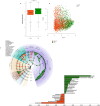Diversity, compositional and functional differences between gut microbiota of children and adults
- PMID: 31974429
- PMCID: PMC6978381
- DOI: 10.1038/s41598-020-57734-z
Diversity, compositional and functional differences between gut microbiota of children and adults
Abstract
The gut microbiota has been shown to play diverse roles in human health and disease although the underlying mechanisms have not yet been fully elucidated. Large cohort studies can provide further understanding into inter-individual differences, with more precise characterization of the pathways by which the gut microbiota influences human physiology and disease processes. Here, we aimed to profile the stool microbiome of children and adults from two population-based cohort studies, comprising 2,111 children in the age-range of 9 to 12 years (the Generation R Study) and 1,427 adult individuals in the range of 46 to 88 years of age (the Rotterdam Study). For the two cohorts, 16S rRNA gene profile datasets derived from the Dutch population were generated. The comparison of the two cohorts showed that children had significantly lower gut microbiome diversity. Furthermore, we observed higher relative abundances of genus Bacteroides in children and higher relative abundances of genus Blautia in adults. Predicted functional metagenome analysis showed an overrepresentation of the glycan degradation pathways, riboflavin (vitamin B2), pyridoxine (vitamin B6) and folate (vitamin B9) biosynthesis pathways in children. In contrast, the gut microbiome of adults showed higher abundances of carbohydrate metabolism pathways, beta-lactam resistance, thiamine (vitamin B1) and pantothenic (vitamin B5) biosynthesis pathways. A predominance of catabolic pathways in children (valine, leucine and isoleucine degradation) as compared to biosynthetic pathways in adults (valine, leucine and isoleucine biosynthesis) suggests a functional microbiome switch to the latter in adult individuals. Overall, we identified compositional and functional differences in gut microbiome between children and adults in a population-based setting. These microbiome profiles can serve as reference for future studies on specific human disease susceptibility in childhood, adulthood and specific diseased populations.
Conflict of interest statement
The authors declare no competing interests.
Figures




Similar articles
-
Gut Microbiome and Serum Metabolome Alterations Associated with Isolated Dystonia.mSphere. 2021 Aug 25;6(4):e0028321. doi: 10.1128/mSphere.00283-21. Epub 2021 Aug 4. mSphere. 2021. PMID: 34346706 Free PMC article.
-
Comprehensive Analysis of Gut Microbiota Composition and Functional Metabolism in Children with Autism Spectrum Disorder and Neurotypical Children: Implications for Sex-Based Differences and Metabolic Dysregulation.Int J Mol Sci. 2024 Jun 18;25(12):6701. doi: 10.3390/ijms25126701. Int J Mol Sci. 2024. PMID: 38928411 Free PMC article.
-
Gut microbiome compositional and functional differences between tumor and non-tumor adjacent tissues from cohorts from the US and Spain.Gut Microbes. 2015;6(3):161-72. doi: 10.1080/19490976.2015.1039223. Gut Microbes. 2015. PMID: 25875428 Free PMC article.
-
Characterizing the Composition of the Pediatric Gut Microbiome: A Systematic Review.Nutrients. 2019 Dec 19;12(1):16. doi: 10.3390/nu12010016. Nutrients. 2019. PMID: 31861722 Free PMC article.
-
The Gut Microbiome, Aging, and Longevity: A Systematic Review.Nutrients. 2020 Dec 7;12(12):3759. doi: 10.3390/nu12123759. Nutrients. 2020. PMID: 33297486 Free PMC article.
Cited by
-
Long-term effects of antimicrobial drugs on the composition of the human gut microbiota.Gut Microbes. 2020 Nov 9;12(1):1795492. doi: 10.1080/19490976.2020.1791677. Gut Microbes. 2020. PMID: 32991820 Free PMC article.
-
Unravelling the gut-brain connection: a systematic review of migraine and the gut microbiome.J Headache Pain. 2025 May 21;26(1):125. doi: 10.1186/s10194-025-02039-7. J Headache Pain. 2025. PMID: 40399789 Free PMC article.
-
Stool metabolome-microbiota evaluation among children and adolescents with obesity, overweight, and normal-weight using 1H NMR and 16S rRNA gene profiling.PLoS One. 2021 Mar 25;16(3):e0247378. doi: 10.1371/journal.pone.0247378. eCollection 2021. PLoS One. 2021. PMID: 33765008 Free PMC article.
-
Fasting: From Physiology to Pathology.Adv Sci (Weinh). 2023 Mar;10(9):e2204487. doi: 10.1002/advs.202204487. Epub 2023 Feb 3. Adv Sci (Weinh). 2023. PMID: 36737846 Free PMC article. Review.
-
The Gut Microbiome of Children during the COVID-19 Pandemic.Microorganisms. 2022 Dec 13;10(12):2460. doi: 10.3390/microorganisms10122460. Microorganisms. 2022. PMID: 36557713 Free PMC article. Review.
References
Publication types
MeSH terms
Substances
LinkOut - more resources
Full Text Sources

